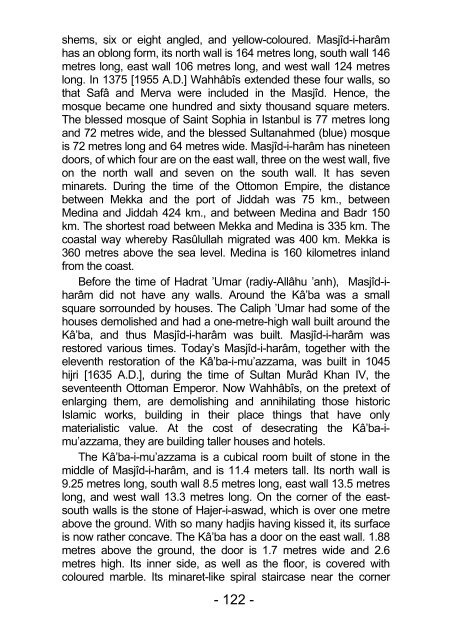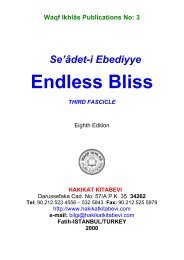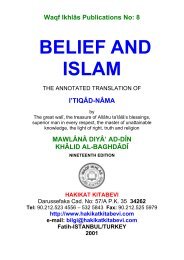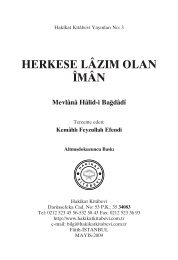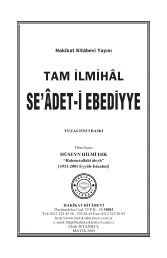5-Endless Bliss Fifth Fascicle - Hakikat Kitabevi
5-Endless Bliss Fifth Fascicle - Hakikat Kitabevi
5-Endless Bliss Fifth Fascicle - Hakikat Kitabevi
You also want an ePaper? Increase the reach of your titles
YUMPU automatically turns print PDFs into web optimized ePapers that Google loves.
shems, six or eight angled, and yellow-coloured. Masjîd-i-harâm<br />
has an oblong form, its north wall is 164 metres long, south wall 146<br />
metres long, east wall 106 metres long, and west wall 124 metres<br />
long. In 1375 [1955 A.D.] Wahhâbîs extended these four walls, so<br />
that Safâ and Merva were included in the Masjîd. Hence, the<br />
mosque became one hundred and sixty thousand square meters.<br />
The blessed mosque of Saint Sophia in Istanbul is 77 metres long<br />
and 72 metres wide, and the blessed Sultanahmed (blue) mosque<br />
is 72 metres long and 64 metres wide. Masjîd-i-harâm has nineteen<br />
doors, of which four are on the east wall, three on the west wall, five<br />
on the north wall and seven on the south wall. It has seven<br />
minarets. During the time of the Ottomon Empire, the distance<br />
between Mekka and the port of Jiddah was 75 km., between<br />
Medina and Jiddah 424 km., and between Medina and Badr 150<br />
km. The shortest road between Mekka and Medina is 335 km. The<br />
coastal way whereby Rasûlullah migrated was 400 km. Mekka is<br />
360 metres above the sea level. Medina is 160 kilometres inland<br />
from the coast.<br />
Before the time of Hadrat ’Umar (radiy-Allâhu ’anh), Masjîd-iharâm<br />
did not have any walls. Around the Kâ’ba was a small<br />
square sorrounded by houses. The Caliph ’Umar had some of the<br />
houses demolished and had a one-metre-high wall built around the<br />
Kâ’ba, and thus Masjîd-i-harâm was built. Masjîd-i-harâm was<br />
restored various times. Today’s Masjîd-i-harâm, together with the<br />
eleventh restoration of the Kâ’ba-i-mu’azzama, was built in 1045<br />
hijri [1635 A.D.], during the time of Sultan Murâd Khan IV, the<br />
seventeenth Ottoman Emperor. Now Wahhâbîs, on the pretext of<br />
enlarging them, are demolishing and annihilating those historic<br />
Islamic works, building in their place things that have only<br />
materialistic value. At the cost of desecrating the Kâ’ba-imu’azzama,<br />
they are building taller houses and hotels.<br />
The Kâ’ba-i-mu’azzama is a cubical room built of stone in the<br />
middle of Masjîd-i-harâm, and is 11.4 meters tall. Its north wall is<br />
9.25 metres long, south wall 8.5 metres long, east wall 13.5 metres<br />
long, and west wall 13.3 metres long. On the corner of the eastsouth<br />
walls is the stone of Hajer-i-aswad, which is over one metre<br />
above the ground. With so many hadjis having kissed it, its surface<br />
is now rather concave. The Kâ’ba has a door on the east wall. 1.88<br />
metres above the ground, the door is 1.7 metres wide and 2.6<br />
metres high. Its inner side, as well as the floor, is covered with<br />
coloured marble. Its minaret-like spiral staircase near the corner<br />
- 122 -


